Catching bait is essential to catching many types of sought-after game fish in both saltwater and freshwater. Catching bait fish that predator fish are feeding on will greatly increase the chances of a productive day of fishing.
Having the correct cast net for the type of bait being targeted is very important. I have thrown cast nets over giant schools of bait and caught zero fish. In general, you want the largest diameter net you can throw with 1-1.5 pounds of lead sinkers per radius foot.
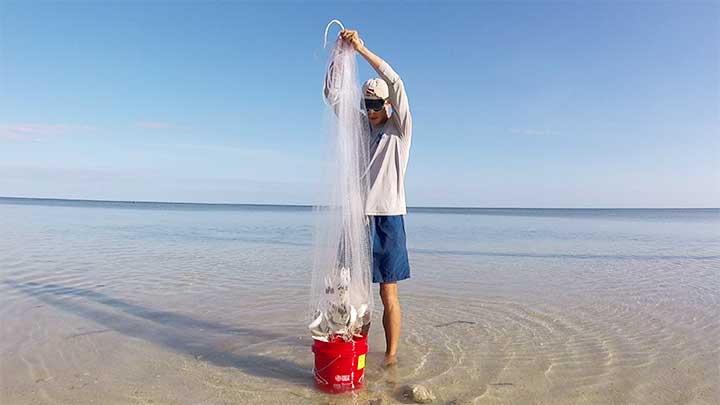
The mesh netting should be small enough to catch the targeted bait but large enough to sink quickly. Having a fast sinking net most important when catching fish that are in deep clear water. Most nets work in shallow water because there is little time for the bait to escape.
Learning how to throw a cast net is the first step. I show two videos below on how to throw cast nets. Practice throwing in the grass or in the water where the area can be disturbed is a great idea. You don’t want to be next to a school of bait you need to catch and be wondering if the net is going to open.
Below I will list many great cast nets and will explain which one is best based on factors such as budget, water depth, and type of bait being targeted.
Here Are the Best Cast Nets
1. Betts Morada Cast Net (Best Overall Cast Net)
Estimated Price: $170-$260
Betts has introduced a new 1.3 pound series to their top quality Morada cast net line. This net was designed in the Florida Keys to catch all types of baits from small pilchards to adult mullet. The mesh size can be selected from as small as 1/4 inch to catch small bait and offers up to 1 inch mesh to catch larger baits in deep water.
Round lead weights are the best type when throwing a cast net. They get snagged less in the net allow it to open evenly and smooth. The 1.3 pound option allows for a lighter overall net when throwing in shallow water. Having 1.6 pounds of lead per radius foot is a heavy net which is good when throwing in deep water to catch cigar minnow, goggle eyes, mullet, mackerel, and bunker. The lighter 1.3 series net is still plenty heavy to catch pilchards, pinfish, ballyhoo, mullet, greenbacks, and sardines. If you are looking for a cheap net, there are better options but this is a great cast net for professional fisherman.
In the video above I show the best way to throw a cast net. It’s a good method that allows you to stay completely clean!
2. Betts Old Salt Premium 4-8 Foot Cast Net with 3/8 Mesh
Estimated Price: $43-$120
This is a great net for most users! This net comes in sizes of 4 foot, 5 foot, 6 foot, and 8 foot. The net has 1-pound of lead weights per radius foot. The 3/8 inch monofilament mesh is good for catching most types of bait.
If you are a beginner or on a budget the Betts Old Salt cast nets are great all-around nets! These cast nets are what I would call the standard or average quality cast nets. With 1 pound of weight per radius foot, the net sinks reasonably fast and is manageable to throw for long periods of time if needed. If this is the first cast net for a user, selecting a net that has a radius that is 1 foot shorter than the thrower is a good idea. This allows for the easiest and most basic throwing technique to be used. Once the user gets proficient they can throw a larger size cast net with more advanced throwing techniques.
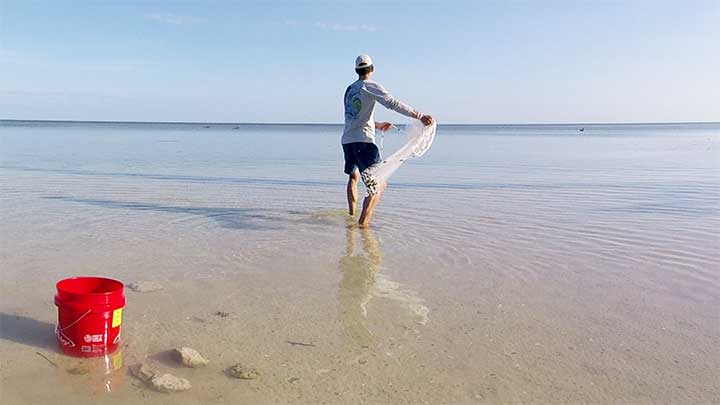
In the picture, I am throwing a 6-foot cast net to catch mullet in shallow water in the Florida Keys.
Betts Old Salt 8-Foot with 3/8 Mesh
Estimated Price: $80-$120
Bettes Old-Salt cast nets are also available in 10 foot and 12 foot. The PM series has a 3/8 inch mesh and the SM series has a 1/2 inch mesh size. This cast net has 1 pound of lead weight per radius foot.
I used the 12 foot version of this net in the video on this page showing how to throw a large cast net. This cast net is of average quality. It is not a high-end 6-panel net but is about half the price. The mesh is lightweight soft, easy to throw, and allows the net to sinks fast. However, the net is not reinforced at the top and bottom and is not made with heavy premium mesh material. For these reasons, it will likely not last as long top quality nets.
These large net will work great for catching pilchards, goggle eyes, scaled sardines, and ballyhoo. The 3/8 inch mesh allows for bait to be caught in shallow and medium depth water. Although it is not top of the line this is still a good cast net that will work for most recreational fishermen.
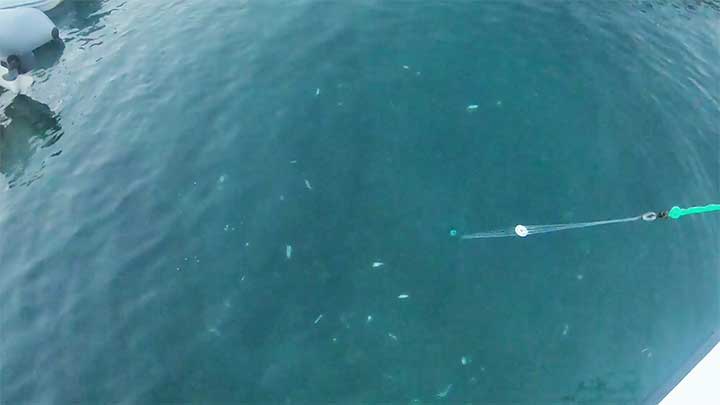
In the picture above I am catching pilchards with a 12-foot cast net in the USVI.
3. Goture Lead Free Cast Net (Best Cheap Cast Net)
Estimated Price: $43-$114
Goture American Saltwater cast nets come in sizes of 4 foot, 6 foot, 8 foot, 10 foot, and 12 foot. A 3/8 inch monofilament mesh size is used. It had 3/4 pounds of irons weights per radius foot. The weights have plastic covers and are lead free. A neoprene wristband is attached to the end of the 32-foot floating hand line. This is the best cast net for beginners and for users catching bait in shallow water. It is good at catching bait in water less than 3 feet deep.
Being light it is easy to throw and the plastic covers on the weights help to not scratch the bottom of the boat. The targeted bait size with a 3/8 inch mesh is 3-6 inches. This same net is available with 1/4 inch mesh to catch smaller bait. It also comes with a bucket large enough to store the cast net. This net will not last as long as a high-end 6-panel net but it is easy to throw and will catch bait in shallow water.
4. Calusa 10-Foot Net with 3/8 Mesh (High End Cast Net)
Estimated Price: $270
Calusa cast net comes in sizes of 8 foot, 10 foot, and 12 foot. Mesh size options are 3/8 or 1/2 inch square mesh. It is weighted with 1.5 pounds of lead weights per radius foot. The top of the net has a 1-1/4 inch horn opening which enables the net to lay flat. This net is built with 120-pound monofilament bail lines.
These Calusa cast nets are known to be one of the most quality cast nets that are commercially available. The nets are hand-tied from 6-panel sections in Thailand. This is how custom nets are made and allows them to lay much flatter when thrown. This net also uses a stronger monofilament mesh net the top and bottom of the net where it is more likely to tear.
This high-end cast net is heavy, quality, and expensive. This is the best net for someone with experience throwing a net that needs to catch lots of bait. If I could only have one cast net this would be it but it not necessarily the best net for beginners. You should learn how to throw and retrieve lightweight low-cost cast nets first.
That being said with my video above on how to throw a cast net, you could learn pretty quickly how to throw any size cast net and catch bait. Just be careful not to get the net snagged on the bottom. Throw the net over grass, mud, sandy bottoms, or in deep water.
Custom Hand Tied Cast Nets
These nets are very similar to custom hand-tied nets that can only be purchased locally in the USA. Purchasing local custom made nets is a great way to get and net. Expert net makers can make custom nets to match the exact user’s needs. However, if you need a net quickly and do not want to wait or do not know of a local net maker this is a great way to go. There is another net made by the same company called a Cracker cast net that is lower cost but is not built with the top-notch quality of a Calusa cast net.
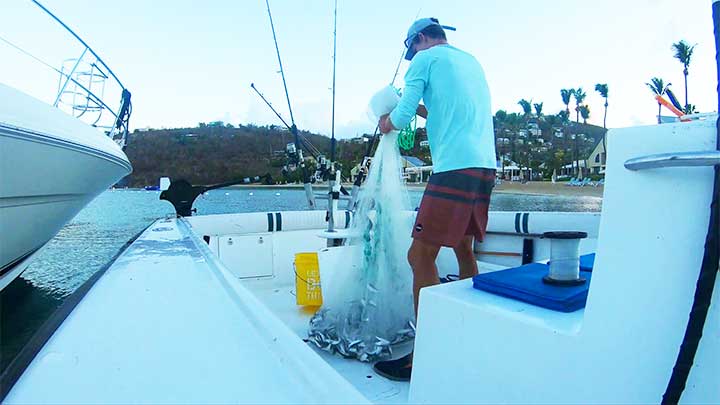
In the picture below putting pilchards in a live well that were caught with a 12-foot cast net in the USVI.
5. Bait Buster 5-12 Foot Net with 3/8 Mesh
Estimated Price: $170-$230
The Bait Buster professional-grade cast net has 3/8 square mesh. This net comes in sizes of 5 foot, 6 foot, 7 foot, 8 foot, 9 foot, 10 foot, and 12 foot in radius. This cast net has 1.5 pounds of lead weight per radius foot. A 25-foot poly braided hand line is used with 100-pound monofilament braille lines.
These nets come with a 3.5-gallon bucket for net storage. The 3/8 inch mesh is good for catching bait 2 inches and up in shallow to medium depth waters. This is a great cast net for catching most types of bait! A 10-foot bait buster cast net with 3/8 inch mesh is a versatile cast net to have on the boat and can catch most types of bait.
The Bait Buster cast nests also come in 1/2 and 5/8 inch mesh sizes. These mesh sizes are good for bait larger than three inches, such as goggle-eye, finger mullet, and small bunker. These mesh sizes will allow the net to sink faster which will work better in deeper water. In general, though the 3/8 inch mesh works well to catch most types of bait, mesh larger than 1 inch is really only needed to catch really large bait like large mullet or bunker.
6. Ahi USA 200 Series Cast Net 3-6 Foot with 3/8 Mesh (Best Small Cast Net)
Estimated Price: $49-$180
The Ahi 200 cast net comes in sizes of 3 foot, 3.5 foot, 4 foot, 4.5 foot, 5 foot, 6 foot, and 7 foot in radius. It has 3/4 pound of lead per radius foot. It is a 6 panel net with a double selvage stitch pattern for 2 times the strength at critical points. The braille lines are 80 pounds and the mesh netting is made with premium monofilament. A 24-foot hand line is connected to a large anodized swivel.
This is the best net for most cast net users. I love having a small 6-foot cast net to catch bait from the shore. The 3/4 pound of lead per radius foot makes it a light net that is easy and fun to throw. Typically, 1-pound of lead per radius foot is desired to allow the net to sink fast. However, this net actually sinks fast and is great for catching bait in shallow water.
Watch the video below where I am using this net to catch mullet. I catch the mullet in shallow water and near the surface in deep water. Often times it is more about cast placement than the size of the net. I can throw this net so far I could often use a longer hand line.
7. Ahi USA 600 Pro Series 1/4 Inch Mesh 5-12 Foot
Estimated Price: $82-$176
This Ahi Pro cast net has 1/4 inch mesh Size options include 5 foot, 6 foot, 7 foot, 8 foot, 10 foot, and 12 foot. It has 1.35 pounds of lead weight per radius foot. Netting material is made with premium clear monofilament mesh netting. Double selvage stitch patterns allow for 2 times the strength at critical points near the top and bottom of the net. Braille lines are made with a 100-pound monofilament. Also included is a bucket that works to store the net.
The small mesh size works well for targeting minnows and shrimp that are 1.5 inches and up. A 3/16 inch mesh is the smallest mesh size they make for cast nets. Small mesh sizes make cast nets sink slower. With the heavy lead weights, this net can catch bait in shallow to medium depth waters.
This net is built with panel sections that allow the net to lay flat and open wide. Getting a quality net with a fast sink rate is important when casting into a school of small minnows in open water. If this is what the big fish are actively feeding then why not catch it and use it for bait!
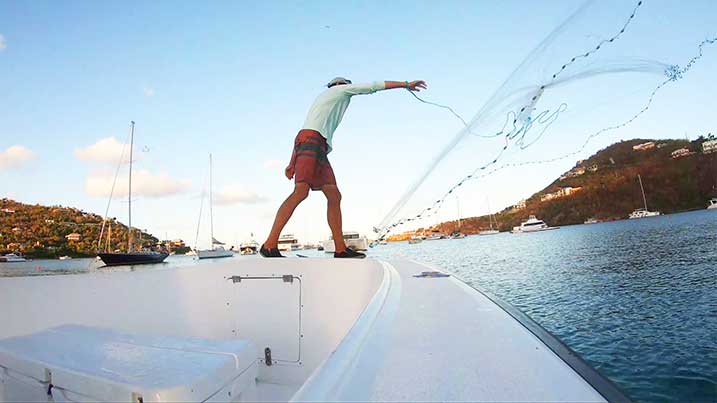
In the picture above I am throwing a 12-foot cast net in the USVI.
8. Mullet Buster Cast Net 6-12 Foot with 1-1/4 Mesh
Estimated Price: $140-$250
Bait Buster Professional Grade Cast Nets have 1-1/4 square mesh. This net comes in 6 foot, 7 foot, 8 foot, 9 foot, 10 foot, and 12-foot radius sizes. This cast net has 1.5 pounds of crimped bar lead weights per radius foot. It is built with 100-pound monofilament braille lines and has a 25-foot poly braided hand line. A 3.5-gallon bucket comes with the net for easy storage. Betts Mullet cast net listed by Bass Pro Shops is similar with 1.3 pound of lead per radius foot and 1 inch mesh.
Large schools of mullet often appear as dark areas in sandy or grassy bottoms or can be breaking the top of the water. Having a fast sinking net is the best way to catch mullets that are deep in clear water. The 1-1/4 inch mesh size with 1.5 pounds of lead per foot is good at catch bait 8 inches and up in deep water.
Manhaden also called bunker are another type of large baitfish that are difficult to catch with a small slow sinking cast net. I bet it is possible to catch large bunker with a small net. However, a large fast sinking cast net is best for catching this type of bait in deep water. I prefer round weights to bar-style weights but depending on the lead line stiffness round weights do not always work well with 1 1/4 mesh. I do not know of a commercially available net with this mesh size over 1 inch that uses round weights.
How to Catch Bunker for Bait with a Cast Net
The video above shows how to catch bunker. Even though you have a large fast sinking net does not mean that catching the bait is guaranteed. When catching bunker we back over them with the boat to send them deep where the fast swimming fish will not be spooked by the splash of the net. Then in the murky waters of New Jersey, the bait can be caught in large numbers.
The cast net I used in this video to catch bunker was a locally made custom Percy cast net that I picked up from Mr. Percy who was very helpful and showed me a method to throw the large net. The net was made from 1 1/4 inch square mesh which is 2 1/2 inch in length when stretched. The net had 1 1/4 pounds of lead per radius foot made from hand-tied evenly space 1-ounce ball sinkers. This is good for baits larger than 7 inches. Really this is a net specifically used for bunker or deep mullet. He makes nets with 1/2 inch square mesh for smaller peanut bunker.
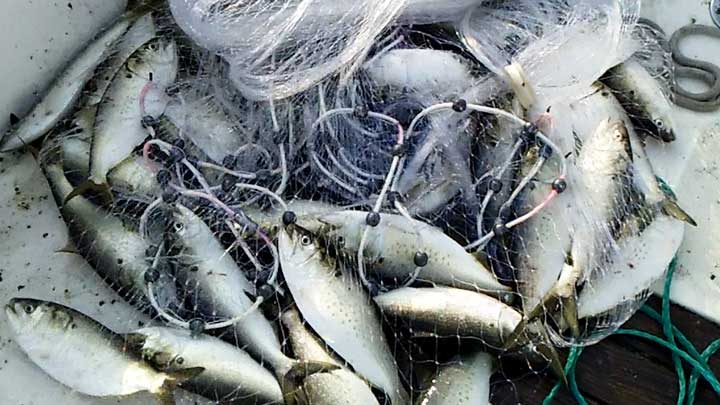
In the picture above I caught menhaden also called bunker with a 10-foot cast net in New Jersey. These baitfish are about 12 inches in length.
9. Offshore Angler Heavy Cast Net
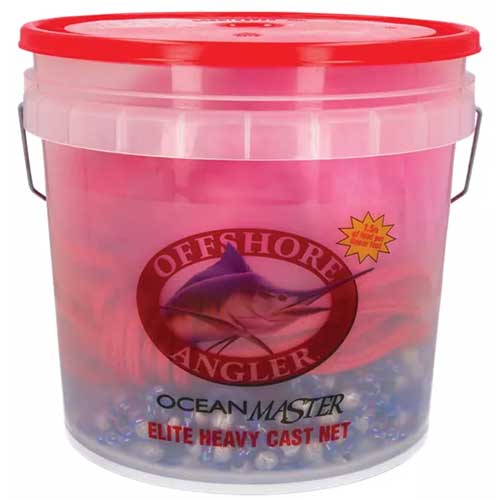
Estimated Price: $220-$230
Bass Pros Shops makes the Offshore Angler Ocean Master cast net. This is a hand tied net with heavy 1.5 pounds of round lead per radius foot. I really like round weights which allow the net to open smoothing, have minimal splash, and sink quickly.
Something unique about this net is that it has pink mesh. This could be advantageous in clear deep water as it may appear less visible to the bait fish. The cast net come in 10 foot and 12 foot radius sizes. Mesh size options are 3/16, 3/8, and 1/2 inch. It it difficult to find a large 10 foot plus size net with 3/16 inch mesh so this is a great option when trying to catch fry fish, silver sides, minnows, small pilchards, and most notably shrimp! It is a good idea to use 3/16 or 1/4 inch mesh when trying to catch shrimp in a cast net. 3/16 inch mesh is the smallest size mesh for any cast net.
10. Wide Open Cast Nets 5-12 Foot
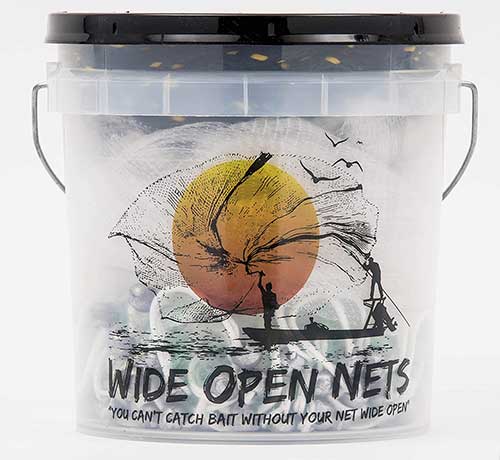
Estimated Price: $150
Wide Open Nets are becoming more popular. These are above-average quality nets and come in many sizes from 5 foot to 12-foot radius. Mesh sizes available are 3/16, 1/4, 3/8, and 1/2 inch square mesh. The company Wide Open Nets is based in Stuart Flordia but the nets are made in China.
Features of the net include a 6-panel hand-tied design, large horn, and 27-foot hand line. Round lead weights are used to allow the net to sink quickly. The nets come in 1-pound or 1.5 pounds of weight per radius foot. For shallow water, 1-pound is a good option. In deep water when targeting fast swimming fish, the 1.5 pound allows the net to sink faster. It does take more effort to throw a heavy net so take that into consideration when selecting the net weight. The lead is tied on each end to secure the weights to the lead line.
11. Cracker Cast Net 10-Foot with 3/8 Mesh
Estimated Price: $200
Cracker cast nets are available in sizes from 6 foot, 7 foot, 8 foot, and 10 foot in radius. Mesh size options are 1/4, 3/8, 1/2, and 5/8 square inch. This is a 6-panel cast net with 1.5 pounds of lead weight per foot. These cast nets are handmade in China and come with a storage bucket.
Cracker cast nets are made by the same company as Calusa cast nets. The Calusa net is more quality by both are premium cast nets.
Differences include stronger monofilament netting at the top and bottom of the Calusa net. These are high-stress areas and the stronger mesh can help the net last longer. Calusa nets are made with the highest quality soft monofilament. Cracker nets also use quality monofilament but are not as soft or as durable with extended use.
The Calusa has more connection with the mesh to the lead line. Calusa nets have 120-pound braille lines and cracker nets have 100-pound braille lines. Finally, the Calusa net has a 1-1/4 inch horn opening which helps the net lay flat during the throw. Cracker nets have a 3/4 inch horn.
12. Betts Super Pro Mono Cast Net 7-Foot with 1/4 Mesh
Estimated Price: $125-$200
Bets Super Pro cast sets come in sizes of 6 foot, 7 foot, 8 foot, 10 foot, and 12 foot in radius. This is a 6-panel net and comes in mesh size options of 1/4, 3/16, 3/8, 1/2, 5/8, and 1-inch clear mesh. Features include premium braille lines, double mesh netting near the lead line, and an extra-strong bonded thread connecting the mesh to the lead line.
The super pro cast net series nets are weighted differently based on mesh size. Mesh sizes of 1/4, 3/16, and 3/8 are weighted are 1.3 pounds per radius foot. For nets with 1/2 inch mesh, the weight is 1.5 pounds per radius foot. Nets with 5/8 inch mesh have 1.4 pounds of weight per radius foot. Finally, nets with a 3/4 inch mesh have 1.7 pounds per radius foot.
The heavier weight with a larger mesh size allows the net to sink fast. This is important when targeting large bait in clear deep water. The Super-Pro series of canst nets are the highest quality nets offered by Betts. These are great nets for avid fishermen and for charter boat operators.
13. Joy Fish Cast Net 8-Foot with 3/8 Mesh
Estimated Price: $144
Joy Professional Bait Cast Net comes in sizes of 4 foot, 5 foot, 6 foot, 8 foot, 10 foot, and 12 foot. Mesh sizes include 3/8 or 1-inch square mesh. This is not a 6-panel net and is weighted with 1.25 pounds of lead per square foot. The netting material is .28 mm blue monofilament and has 80-pound braille lines.
I have used this net in the 8-foot and 12-foot sizes. At first, I was skeptical of the blue mesh material. However, using this in clear water to catch pilchards, goggle eyes, and scaled sardines I noticed no difference in catch rates to clear monofilament. This is not a 6-panel net but has soft mesh material that allows the net to open wide.
This is not the highest quality net on the market but does a good job of catching bait. The durability is not as good as top quality nets but I did use this net to catch bait every day for several months without any unexpected issues. The net did tear when snagging bottom and large fish unintentionally caught did punch holes through the net but this is expected with any cast net.
14. Mako Cast Net 4-7 Foot with 3/8 Mesh
Estimated Price: $70
Mako bait cast net comes in sizes of 4 foot, 5 foot, 6 foot, and 7 foot. White monofilament is used for the netting material which is .23 mm thick and 3/8 inch square mesh which is 3/4 inch stretched. The netting material has a 7-15 pound break strength. Braille lines are made with an 80-pound monofilament.
These cast nets work well to catch bait like mullet, pilchards, threadfin herring, and pinfish. A good bait size to target is 3 inches to 6 inches. The net is made by Lee Fisher which has been making cast nets for over 30 years. Other nets they make include Bait Buster, Humpback, and Joy Fish.
15. Betts Buddy Cast 3-5 foot with 3/8 Mesh (Best Cast Net For Kids)
Estimated Price: $26-$56
Betts Buddy cast nets come in sizes of 3 foot, 4 foot, and 5 foot. The Mesh size for the nets is 3/8 inch. Coated iron weights are used to weigh the net at 3/4 pound per radius foot. A bright chartreuse monofilament line is used for the netting material. This allows parents to keep an eye on their kids that are using the net. It might not be the best color net to have but it still catches plenty of fish.
I really like that this is a lead-free cast net for kids. Heavy lead weights are not needed to catch bait in shallow water. Kids probably have more fun throwing a cast net on a fishing trip than they do fishing. There is constant action and you never know what you are going to catch.
The only problem kids have is learning to throw a cast net. Check out my page on How to Throw a Cast Net for more information.
16. Ahi USA 50 Series Monofilament Cast Net 3-7 Foot
Estimated Price: $42
Ahi USA 50 series cast nets come in sizes of 3 foot, 4 foot, 5 foot, 6 foot, and 7 foot. Steel weights with vinyl covers are used to weigh the net at 3/4 pound per radius foot. Premium clear monofilament netting is used with 80-pound braille lines.
This is a good net to use in shallow water. It is similar to the Ahi 200 series except this net uses steel weights. For the price, this is a good net is a good value. I would recommend this net for kids because it is a lead-free option, has clear mesh, and is quite durable.
17. South Bend Lead-Free Cast Net 4-Foot with 3/8 Mesh
Estimated Price: $27
This South Bend Cast net comes in sizes of 3-foot or 4-foot. The mesh is made with clear monofilament and has 3/8 inch square mesh. Steel weights are used and have plastic covers.
This is a low0cost net that is good for kid or adults that are catching bait in shallow water. A 4-foot cast net is pretty small but can still catch lots of cool fish. A three-footer is the smallest cast net they make and is more difficult to catch bait with. I like cast nets that are lead-free for kids to use.
South Bend Cast Net 7-foot with 3/8 Mesh
Lightweight Cast Nets with Steel Weights
Estimated Price: $34-$90
This South Bend cast net has a 7-foot radius. It has clear monofilament netting with 3/8 mesh. It is manufactured in China. This is the same cast net reviewed above but has a large radius.
These cast nets are just about the lowest cost nets on the market. They are not high end but do work to catch bait. The steel weights are considered environmentally friendly.
In some ways having a light net is an advantage. Throwing cast nets all day causes fatigue and it is just a hassle using heavy cast nets. When throwing nets in water less than three feet deep lots of baitfish will be caught even using small lightweight nets. A 7-foot net is a good size net for catching bait from shore. It can be thrown far and is still large enough to catch lots of fish with each cast.
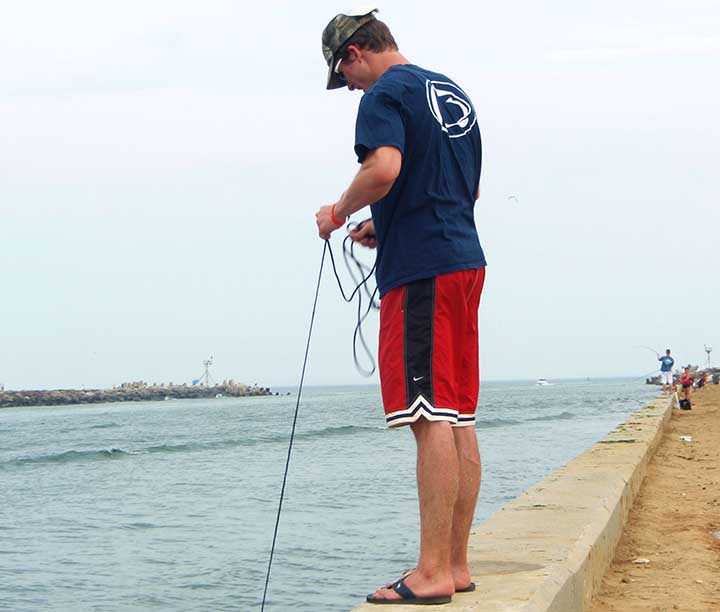
18. Winged Chain Bottom Cast Net 5-12 Foot with 3/8, 1/2, and 1 Inch Mesh
Estimated Price: $60-$160
The winged fish cast net comes in sizes of 5 foot, 6 foot, 7 foot, 8 foot, 9 foot, 10 foot, and 12 foot. Mesh size options are 3/8, 1/2, or 1 inch. This is a quality elite series 6-panel cast net. It is unique because it is weighted at 1 pound per radius foot with a steel chain around the perimeter of the net. This style of net is called a chain bottom cast net. It also comes with a 30-foot hand line.
Chain bottom nets are said to open more easily and uniformly than other cast nets. They also claim to reduce tangles and close better on the bottom. I personally have not used a chain bottom net so I can not say whether these claims are accurate. This does seem like a quality net that would catch bait. My only concern would be whether the chain dragging on the floor of the boat would cause any issues. When loading cast nets with lead weights it is already quite loud and noisy. It is possible that is chain bottom net would actually be better. I also wonder if the chain noise would spook the fish or not. My guess is that these are not problems and that the net would work well.
19. Fitec Super Spreader Cast Net 5-8 Foot with 3/8 Mesh
Estimated Price: $42-$93
Fitec Super Spreader casts net comes in 5 foot, 6 foot, 7 foot, and 8-foot sizes, measured by the radius of the net. A comfort kuff made of elastic materials comes at the end of a 26-foot hand line. The lead line had 1 pound of lead per radius foot. Netting material is made from blue monofilament and has 90-pound braille lines.
The company Fitec has been making cast nets since 1984. Other models include the EZ throw, Ultra Spreader, RS series, GS series, Taped Deepwater series, and chain net series. The Super Spreader series is not a 6-panel cast net. It is popular an average quality cast net that is a good value.
20. Drasry Saltwater Fishing Cast Net 4-8 foot with 1/2 Mesh
Estimated Price: $38-$96
The Drasry cast net comes in sizes of 4 foot, 5 foot, 6 foot, 7 foot, and 8 foot. Mesh options are 3/8 inch clear monofilament or 1/2 inch brown tire line mesh that is treated to be durable and not tear easily. The hand line is 43-49 feet and has a comfortable neoprene wristband at the end. This hand line is connected to the net with a strong swivel. A portable carry bag is included but in most cases sorting the net in a bucket is a better option.
The net used lead weights but is not quite 1 pound per radius foot. For example, the 4-foot net weighs a total of 3.53 pounds and the 8-foot net weighs 7.05 pounds. The tire line cast net durability is an attractive feature of this net. I really like the long hand line but for beginners, it is more work and could get tangled more often. This is a good net for trowing from shore to catch large baits because it has a 1/2 inch mesh size.
21. Ahi USA 500 Pro Series Cast Net
Estimated Price: $160-$180
Ahi USA 500 series cast nets come in sizes of 6 foot, 7 foot, 8 foot, 9 foot, 10 foot, and 12 foot. This is a 6 panel net with a 3/8-inch square mesh size. It has 100-pound test braille lines and 1.25 pounds of lead per radius foot. Also included in a plastic storage bucket.
This is a medium quality cast net. The large mesh size and lead weight allow the net to sink fast and catch large bait such as mullet and bunker in deep clear water. This is one of the few nets on the market with a large 1-inch square mesh size which would be 2 inches stretched.
22. Hurricane Cast Net 5-Foot with 3/8 Mesh
Estimated Price: $35
The Hurricane cast net has a 5-foot radius which means the diameter is 10 feet across. It has 3/8 inch monofilament mesh and monofilament braille lines. This cast net can be used in both fresh and saltwater. It has 1 pound of lead per square foot attached to the lead line.
This cast net is a great value. It is a good cast net for beginners to practicing casting without risking damage to an expensive cast net. Having 1 pound of lead per square foot this net will sink fast enough to catch lots of baitfish. Even though it is low-cost does not mean it does not work well. It might not last as long as other nets but sometimes a basic net like this is all that is needed to catch some bait for a great fishing trip.
23. Ez Throw Cast Next 4-Foot with 3/8 Inch Mesh
FITEC EZ Throw Super Spreader cast net with an aluminum ring. This net has a 4-foot radius and has 3/4 pounds of weights per radius foot. The hand line is 20 feet and is made from a polyethylene material which allows the line to float. This net works to catch bait 2 inches and up in shallow water. It comes with an instructional DVD on how to throw the net.
The easy throw cast nets with aluminum rings demonstrate the easiest way to throw a small cast net. I would not recommend buying this unless you are really struggling to throw a cast net. The ring is unnecessary and it makes it a pain to store the net. The method used to throw the net is the best way for a beginner to throw and works if the net is about 1 foot shorter than the user.
Easy Way to Throw a Cast Net
The basic method to throw a cast net starts by having the net by your right side if you are right-handed. Hold it at the horn(top of the net) with your dominant hand and pick up the lead line in one spot with the other hand. Place the lead line over the top of the horn and your dominant hand. Grab the lead line about 2 feet down the lead line with your non-dominant hand and you are ready to throw. When throwing swing the net out with your dominant hand and pull back the lead line in your non-dominant hand. The net should open right up.
With the EZ throw ring when the lead line is brought to the top of the net it is wrapped around the ring rather than the horn. This is largely unnecessary but may help with the initial concept if you have never thrown a cast net. This general approach is how I have thrown nets under 5 foot and I am over 6 feet tall. With a 6 foot net, it drags on the ground while swinging during a cast and gets caught on everything. This can be overcome by starting 1 foot down the net if the 13-inch metal ring is not on the net.
Lee Fisher Joy Fish Basket for Cast Net Storage
This Lee Fisher Joy heavy-duty fish basket can be used for multi-purposes. In this case, it works perfectly for storing large cast nets. Color options are blue or green and similar baskets come in orange. These baskets are commonly used to transport, shrimp, crabs, lobster, and fish that are caught by commercial fishermen.
These work great for cast net storage because the holes in the basket allow the cast net to dry. A large cast net should ideally be rinsed and hung up each day. This basket allows the cast net to be easily rinsed with fresh water. Ideally, the case net would not be stored in the sun so placing the basket in a shading area is a good idea.
Frequently Asked Questions
How do you throw a cast net?
Check out the How To Throw a Cast Net page, for detailed instructions on how to throw a cast net. There are three common ways to throw a cast net. For large cast nets, the most common method is the triple load method. This method works well but the net is placed on the shoulder. After throwing the net the first time the net is wet and the user gets messy after the first throw.
The second common way to throw a cast net is called the easy throw method. This works well for cast nets under 5 feet in radius. This method is quick and easy but does now work for large cast nets. Finally, the third method does not have an official name but is the best way to throw any size cast net. It is fast clean and works well with big and small cast nets. The triple load method is thrown mostly with the left hand. The benefit of the other two methods is it works by throwing the cast net with the right hand. As a right-handed person, this is more natural and allows me to throw the cast net further.
There is no right or wrong way to throw a cast net. If you can throw the net far and have it open enough to catch bait then the cast net has served its purpose. However, there are methods that make throwing the cast net less work and more enjoyable. Catching bait is very important and should be a fun part of a fishing trip.
What fish do you catch with live bait?
Catching live bait is very important when fishing in the ocean. Common fish caught on live bait include mahi-mahi, tuna, king mackerel, striped bass, and tarpon. Live bait is typically best but in many cases, fresh-cut dead bait works very well. On some days lures work great to catch fish. However, the most consistent way to catch fish is by using live bait. Inshore fishing and reef fish both heavily rely on live bait. Shrimp and squid both work as backups but it is hard to beat a live minnow.
Freshwater fishermen often overlook using live bait. Common freshwater fish caught with live bait include bass, catfish, crappie, and hybrid striped bass. It is important to check the local regulations when using cast nets in freshwater. Sometimes creek chubs work really well to catch bass, especially in pounds. Also, hybrid striped bass are frequently caught at night using alewife which is a type of herring. For catfish, dead stinky bait is important to attract the catfish but live bait works well. Most crappie fishermen know that small minnows work good day or night for crappie fishing. Most often minnows are tipped on a small jig and placed at different depths.
What is the best size cast net?
For beginners, it is best to get a cast net under 8 feet in radius. This is because it is nice to learn how to properly handle a cast net without dealing with a huge cast net. The most difficult thing to learn is how to properly untangle the cast net. Another important thing to learn is how to not get the net snagged. Every step of the cast net process is easier with a smaller cast net. However, more throws are often needed to catch the same amount of bait.
For kids, the best size cast net is between 3 feet and 6 feet depending on the size and experience level of the child. In most cases, I would say a 4-foot cast net is best for kids. It is easy to throw and it is amazing at how much fish it can still catch.
If I was told I could only have one net I would probably get a 10-foot net with 3/8 mesh. This is a versatile net that can catch almost any kind of bait such as pilchards, ballyhoo, bunker, shad, pinfish, and mullet. I also really like having a small 6-foot net with a 3/8 inch mesh that I can cast far from shore in the shallows.
That said it also really depends on what type of bait I need to catch for the day. When catching large bunker in New Jersey is important to use a cast net that is 10 feet or bigger with a large mesh around 1 inch so that the net sinks fast enough to catch the bait. In clear deep water, it is also important to throw a large net with large mesh to catch baitfish like mullet.
What is the best mesh size for a cast net?
The best mesh size for a cast net depends on what type of bait is trying to be caught. In almost all cases the mesh size is given in terms of square mesh, not stretched mesh. Stretched meth is the diagonal length between knots and is about double the square mesh value. For example, 1/4 inch square mesh is 1/2 inch when stretched and 1-inch square mesh is 2 inches when stretched.
Small size mesh is 3/16 inch and 1/4 inch square mesh netting material. This size mesh is primarily used to catch minnows and shrimp between 1 and three inches. Sometimes these are called fry cast nets.
The most popular size mesh material 3/8 inch. This is a versatile net size because the net can cast small 3 inches baits and still sinks fast enough to frequently catch large baits like mullet and goggle eyes. Common baits caught with 3/8 inch mesh include shrimp, pilchards, scaled sardines, threadfin herring, pinfish, speedos, finger mullet, shad, and ballyhoo.
Medium size mesh is 1/2 and 5/8 inch square mesh. These mesh sizes work well to catch bait between 4 inches and 10 inches. Common baits caught with these mesh sizes include finger mullet, goggle eyes, and cigar minnows.
Finally, mesh that is 1 and 1-1/4 inches is used to catch mullet and bunker over 10 inches. These large baits can often evade a slow sinking net. However, in shallow water, large baits can be caught with a smaller mesh size.
How do you care for a cast net?
Taking care of the net will make it perform better and last longer. The main thing to do is store it in a cool dry location out of the sun. A commercial fishing basket is a great option because it is open to the air and has holes in the bottom which allows water to drain. Once a net is dry it can be stored in a bucket for long-term storage. Every once in awhile the net can be soaked for a few hours in fabric softener to clean, wax, and loosen the net. This does lubricate the lines which can cause knots to come untied so this should only be done when needed.
Many charter fishing companies will rinse and hang the cast net each day to keep the net in good condition. Personally, I think this seems quite time-intensive to actually hang the net. However, the cast net should defiantly be put away clean, without holes, and untangled each day. It is a very bad situation when you need to catch bait and your cast net is tangled, and dirty.
How do you repair a cast net?
It is very common for a cast net to have braille lines break, netting get torn, and have large fish punch holes through the cast net. A new cast net is not needed each time this happens.
The easiest way to repair a hole or tear is by tying knots in the mesh with a 10-30 pound test fishing line. Personally, I use a 30-pound test monofilament fishing line and tie a uni knot. A knot should be tied about every 1-inch along the hole or tear.
If a braille line breaks it is important to fix it or the cast net will not close properly. Locate where the braille line broke and use a 60-80 pound test line to repair the braille line. Often times a double unit knot is needed to add extra length back to the braille line. The braille line can be connected to the lead line with a basic uni knot.
It is unusual for the lead line to break but the mesh along with the lead line is a common place for the net to tear. This can be repaired the same way as the mesh netting with a 10-30 pound fishing line used to tie knots every 1-inch.
How does a cast net catch fish?
A cast net is a circular mesh net with a 6-24-foot diameter. Along the perimeter of the net are lead or steel weights. The weights are connected to the lead line which is connected to 16-26 braille lines which are evenly spaced and tied along the lead line. A hand line is connected to the braille lines using a large swivel. Mesh netting is connected to the lead line on the bottom and horn at the top. The horn slides over the braille lines as the cast net closes.
The cast is thrown by a single person and opens in a circle. As it sinks it traps most types of baitfish. When the hand line is pulled up the bottom of the net is closed because the braille lines pull the net together. This results in trapped bait that can be quickly emptied into a live well.
Captain Cody has worked on charter fishing boats in the Florida Keys, Virgin Islands, and Alaska. Growing up in Pennsylvania Cody has also done extensive freshwater fishing including bass fishing tournaments. Cody strives to provide detailed information about the best fishing gear and tactics to help both novice and experienced anglers have a more productive and enjoyable time on the water. Cody also has a background in aerospace engineering and neuroscience but really only takes pride in being good at one thing and that is fishing!

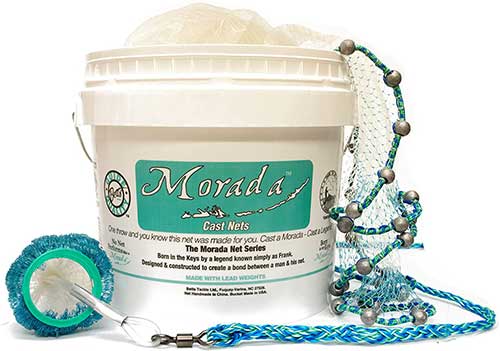
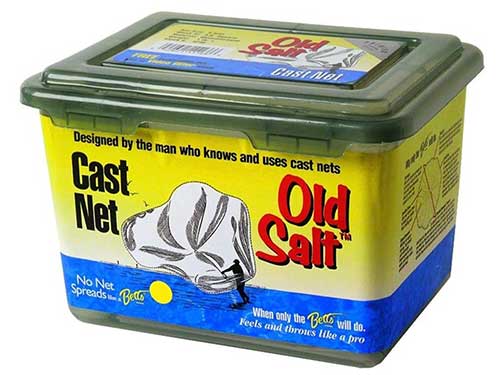
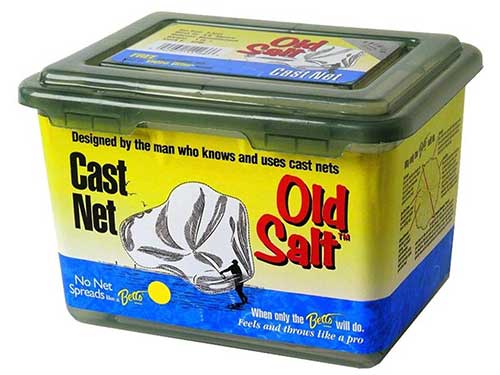
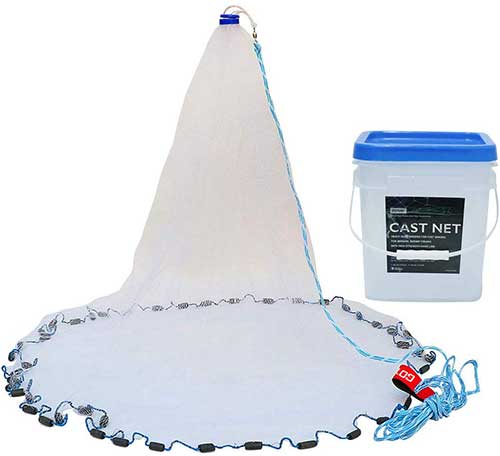
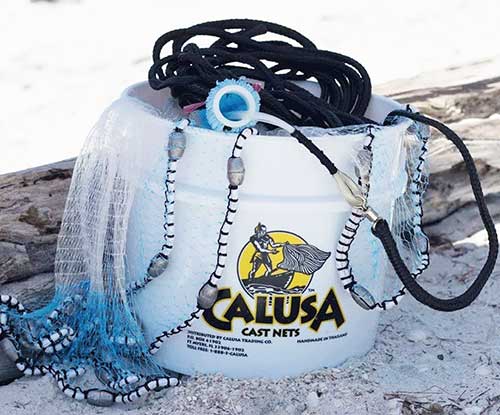
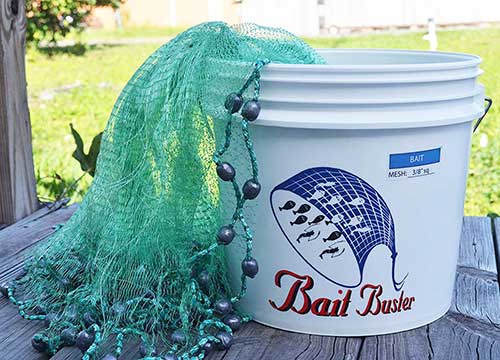
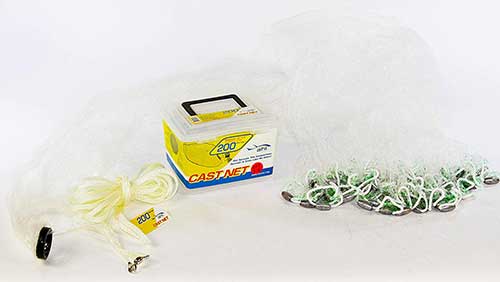
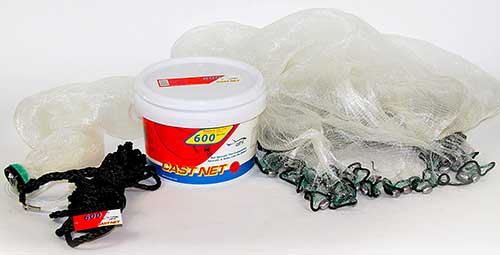
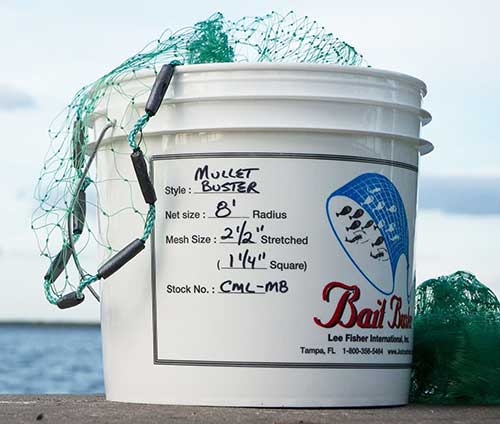
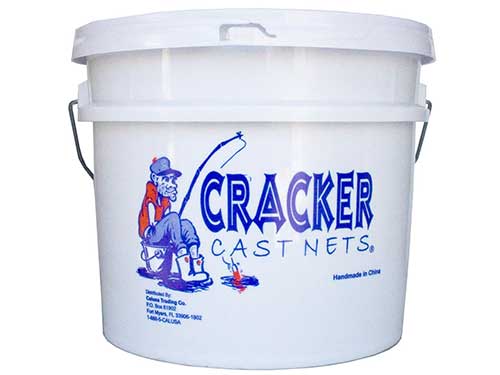
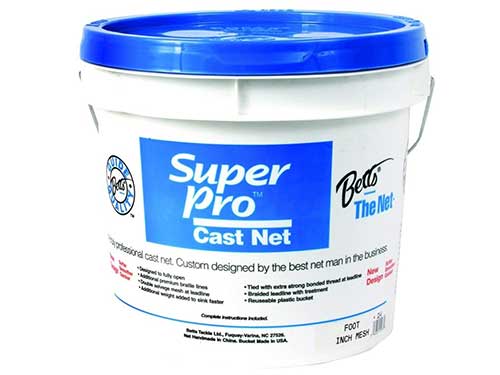
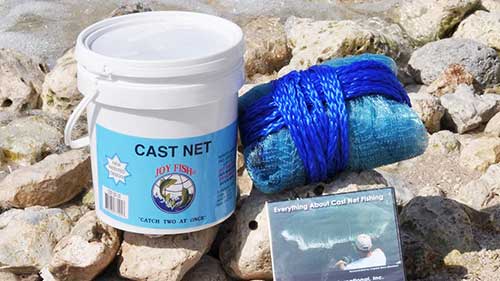
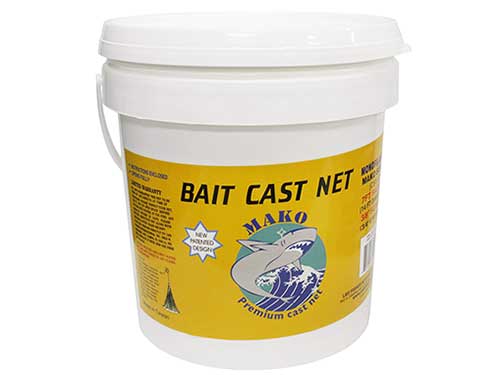
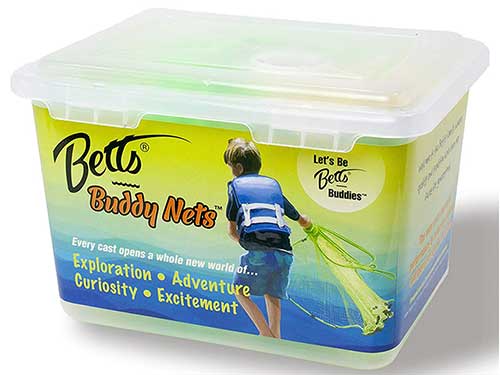
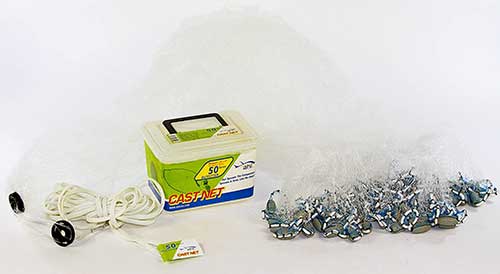
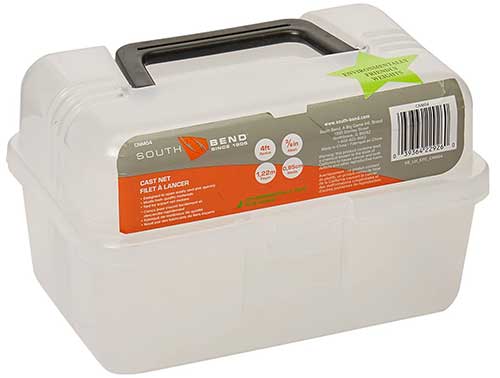
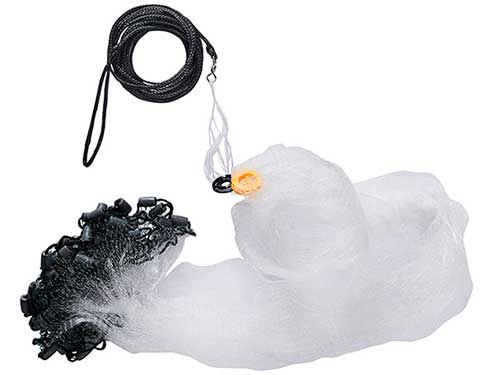
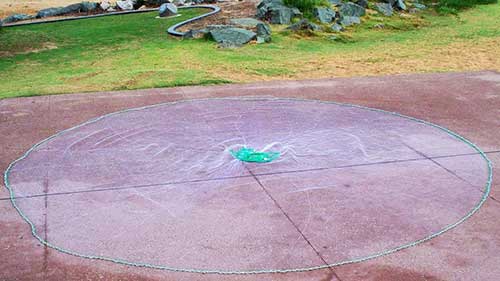
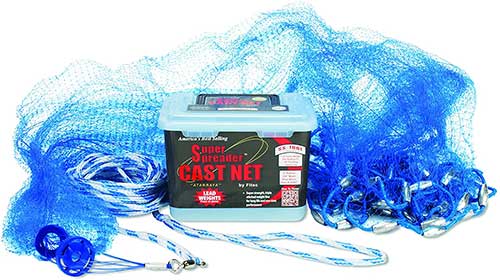
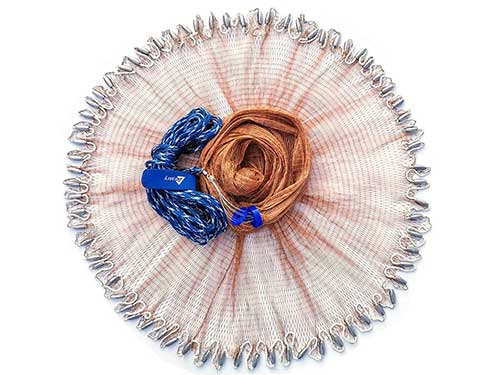
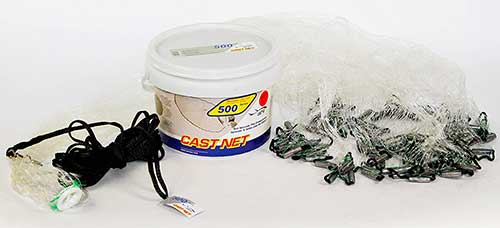
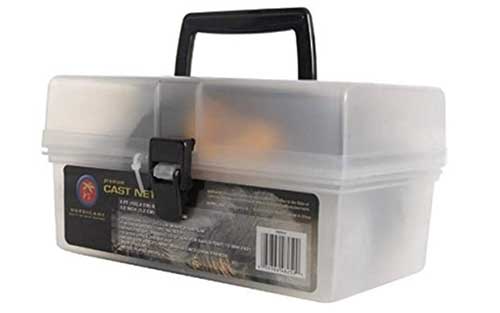
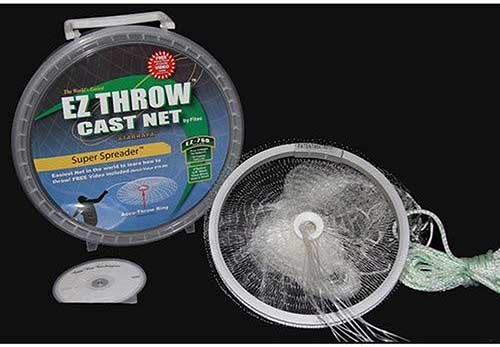
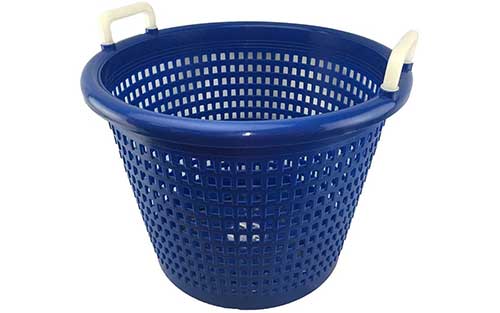
What are your thoughts on a good deep hole shrimp net?
I am not positive on shrimp cast nets. It probably depends on the size of the shrimp but I think most people use mesh size smaller than 3/8 so 1/4 or 3/16. The bigger nets with more lead will likely catch more shrimp. Just make sure you are throwing it somewhere it will not get snagged if you are sinking all the way to the bottom. Lots of people do catch shrimp with cast net though.
Great rundown and nice detail. There are so many choices out there and it takes a while to figure out all the options. I burn thru 2-3 cheap nets a year due to the terrain, meaning heavy thick brush on theach bottom, but it is nice to throw a high quality net once in a while. There is a big difference but you get what you pay for.
Hello I like ur 3/8 mesh but am looking for a 12 foot with 1/8 mesh casting net hope u can help me find one thanks .
The Ahi USA 600 Pro Series 1/4 inch mesh is about the smallest I know off. Thier are 3/16 ich mesh nets out their but I have not heard of 1/8 inch mesh. That is very small.
Excellent tips! I am getting back into fishing after a long absence. I appreciate the easy to understand format you put this all into.